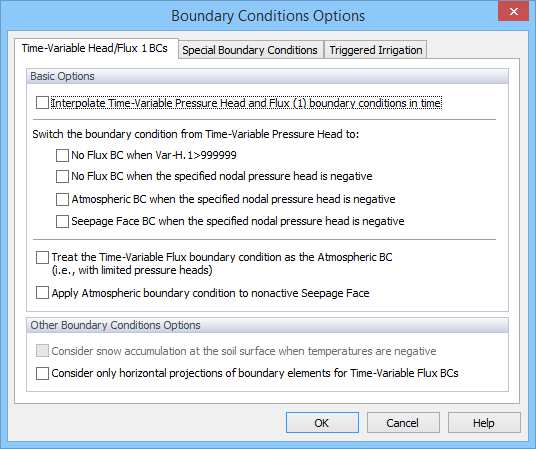
The options that are available on the first tab (Time-Variable Head/Flux 1 BCs,) apply to the first Time-Variable Head/Flux boundary condition. The following new options are available here:
- Interpolate Time-Variable Head/Flux BC in time: While in version 2.0 of HYDRUS-2D, all boundary conditions (i.e., fluxes or pressure heads) changed in abrupt steps, the new version allows boundary pressure heads to change smoothly with time. Abrupt changes in the pressure heads lead to sudden changes in fluxes, while smoothly changing pressure heads provide smoothly changing fluxes. An example of such a boundary condition is the water level in a stream or furrow.
- No Flux BC when Var.H.1>999999: While version 2.0 of HYDRUS-2D only allowed either time-variable pressure heads or time-variable fluxes on a particular part of the boundary, the new version allows boundary conditions to change from variable pressure heads to a zero flux and vice-versa. This boundary condition can be used for example for a disc permeameter where the specified head changes to a zero flux during time periods when the permeameter is re-supplied with water. The zero flux is initiated by specifying a value larger than 999999.
- No Flux BC when the specified nodal pressure head is negative: When a time-variable pressure head boundary condition is specified along a boundary, then the specified value is assigned to the lowest nodal point of a particular boundary, while pressure heads at other nodes are adjusted based on the z-coordinate. When this option is selected, then nodes with calculated negative pressure heads are not associated with a Dirichlet boundary condition, but rather with a zero flux. A fluctuating water level in a stream or furrow is an example of this type of boundary condition. While positive pressure head values are below the water table, negative values occur above the water table.
- Atmospheric BC when the specified nodal pressure head is negativeThis is similar to c) except that an atmospheric boundary condition is assigned to nodes with negative calculated pressure heads.
- Seepage Face BC when the specified nodal pressure head is negativeThis is similar to c) except that a seepage face boundary condition is assigned to nodes with negative calculated pressure heads. Note that a Seepage Face boundary condition needs to be assigned to all boundary nodes, for which this option is to be used.
- Treat the Time-Variable Flux BC as the Atmospheric BC: When this type of system-dependent boundary condition is selected, then HYDRUS treats the time-variable flux boundary conditions similarly as atmospheric fluxes. This means that pressure heads have two limiting values, with the maximum pressure head equal to hCritS and the minimum pressure head equal to hCritA.
- Apply Atmospheric BC to nonactive Seepage Face: While in version 2.x of the code, the flux across the nonactive part of the seepage face was always equal to zero, the new version can apply atmospheric boundary conditions on a nonactive seepage face.
- Consider snow accumulation at the soil surface when temperatures are negative: When heat transport is simulated simultaneously with water flow and atmospheric boundary conditions, then snow accumulation on top of the soil surface can be simulated. The code then assumes that when the air temperature is below -2 C all precipitation is in the form of snow. When the air temperature is above +2 C all precipitation is in the form of liquid, while a linear transition is used between the two limiting temperatures (-2,2). The code further assumes that when the air temperature is above zero, the existing snow layer (if it exists) melts proportionally to the air temperature.
Boundary condition options a) through g) (except for f) can be used only with the first time-variable head condition.
Back to Boundary Condition Options.
See also the "How to Edit Boundary Conditions" topic.
